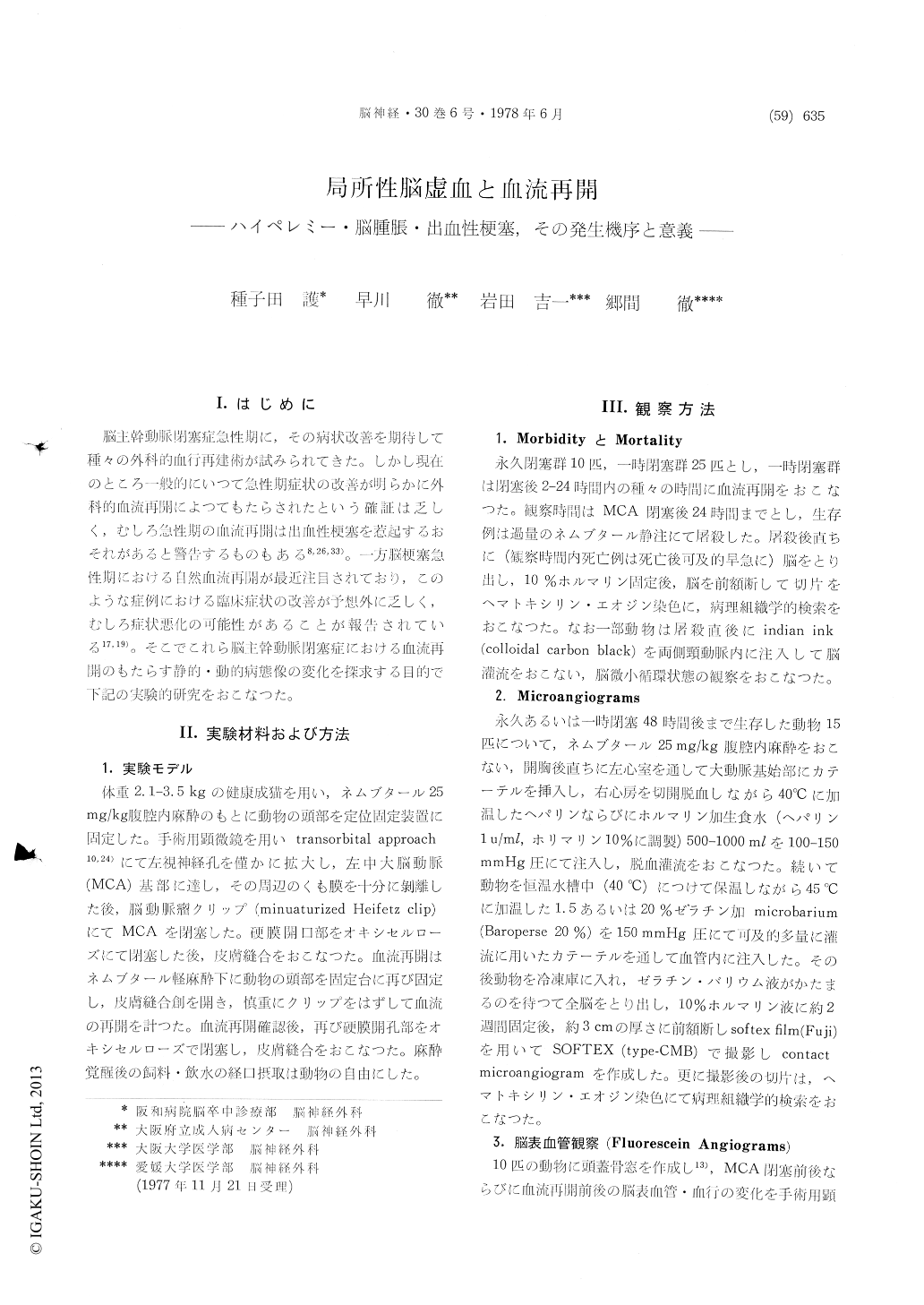Japanese
English
- 有料閲覧
- Abstract 文献概要
- 1ページ目 Look Inside
I.はじめに
脳主幹動脈閉塞症急性期に,その病状改善を期待して種々の外科的血行再建術が試みられてきた。しかし現在のところ一般的にいつて急性期症状の改善が明らかに外科的血流再開によつてもたらされたという確証は乏しく,むしろ急性期の血流再開は出血性梗塞を惹起するおそれがあると警告するものもある8,26,33)。一方脳梗塞急性期における自然血流再開が最近注目されており,このような症例における臨床症状の改善が予想外に乏しく,むしろ症状悪化の可能性があることが報告されている17,19)。そこでこれら脳主幹動脈閉塞症における血流再開のもたらす静的・動的病態像の変化を探求する目的で下記の実験的研究をおこなつた。
The middle cerebral artery of cats was occluded permanently or temporarily (2-24 hours) via transorbital microsurgical approach in cats. And the changes of clinical neurological state, microangio-grams and observation of superficial cerebral microvasculature through a cranial window and its fluorescein angiograms, were studied.
The results obtained lead to the following views and conclusions:
(1) The restoration of blood flow in cerebral infarction may frequently be followed by acute neurological deterioration and death. The cause of such death may be related to acute brain swelling and transtentorial herniation. Hemorrhagic infarc-tion is sometimes found in such cases but may not be the direct cause of death.
(2) Passage of flow in the majority of the vessels might be well maintained even in the territory of the occluded major cerebral artery in acute stage, because the infused microbarium of low viscosity well filled even fine arterioles in the infarcted lesion.
(3) Perfusion pressure of the infarcted lesion might be low, because the medium of higher viscosity could not fill the fine vessels in the infarcted lesion.
(4) Intravascular pressure in the infarcted lesion might increase after recanalization of the occluded artery, because the medium of higher viscosity well entered the vessels in the infarcted lesion after recanalization.
(5) The observation of cortical surface through a cranial window would indicate that cerebral ischemia might diminish in various degree by restoration of flow.
(6) Restoration of flow may cause reactive hyperemia in the previously ischemic area and be followed by extravasation resulting in brain edema. Reactive hyperemia, itself, may also be one of the causes of brain swelling by increasing cerebral blood volume.
(7) Reactive hyperemia might worsen the exsistent brain swelling and edema in cerebral infarction and result in unfavorable clinical courseafter recanalization of the occluded cerebral artery.
Up to date, attention has been paid largely to the hemorrhagic infarction as a direct cause of fatal outcome in recanalized cerebral infarction. The pathogenesis of reactive hyperemia may directly be concerned in production of hemorrhagic infarction; i. e., hemorrhagic infarction may be its drastic manifestation or outcome. Evidence to date,however, would indicate that the most important and fundamental phenomenon as the cause of un-favorable clinical course in recanalized cerebral infarction might be reactive hyperemia resulting in excessive brain swelling, through the manifestation of hemorrhagic infarction accompanied in some of these cases is impressive.

Copyright © 1978, Igaku-Shoin Ltd. All rights reserved.


